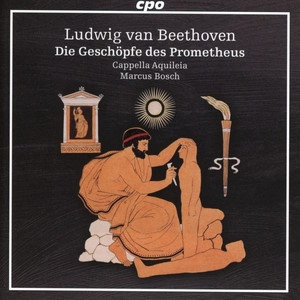
Ludwig van Beethoven (1770-1827)
Die Geschöpfe des Prometheus, Op. 43 (1801)
Cappella Aquileia/Marcus Bosch
rec. 2020, Festspielhaus Congress Centrum Heidenheim, Germany
cpo 555 303-2 [62]
The only bit of Prometheus most listeners know is the overture, with its fleet, feathery violin runs. At the start of the piece, I wondered whether the period-practice movement had taken over. The opening tutti chords are short, crisp thwacks rather than the usual massive tenutos, and at a markedly faster tempo than usual which, at least, makes the triple meter immediately clear. Seeing the ensemble’s offbeat name, I rather feared this would be a “historical” performance.
Well, no fear. Capella Aquileia, a versatile modern ensemble, is the orchestra of the Heidenheim Opera Festival; and, once the overture reaches the Allegro molto con brio, the tempo reverts to the customary one – string players, no matter the instruments, can only manage so much brio. The rest of the performance follows conventional lines.
Ballet as a form would seem to be temperamentally foreign to the volatile Beethoven – though other Classical ballets, like Gluck’s Don Juan, are governed by the same sort of formal rigor that governs those composers’ other works. On the CPO disc, Marcus Bosch manages to do justice to Beethoven without losing sight of the balletic element – or, perhaps, vice versa. After that overture, the Introduktion is stormy and the first act opens with a nice Classical gravitas; the conductor infuses the Adagio with a sizzling tension. The Maestoso Act Two opening feels large-scaled. The Allegro con brio (track 10) has a triumphal mood; so does the stately, Marseillaise-ish Coro di Gioia (track 14), which, despite its airborne line, comes off as symphonic rather than balletic.
On the other hand, the dotted rhythms in the Allegro vivace (track 5) have a graceful lift – just like a “real” ballet, I wrote in my notes – and the chipper articulations of the Un poco Adagio (track 8) are playful. The oboe in the Pastorale (track 10), while a bit cutesy, does supply an appropriate pastoral mood. The last four movements of the score, the most substantial ones, aren’t quite my idea of “balletic”: the Finale (track 18) actually hands us what would become part of the Eroica‘s Finale.
Unfortunately, Bosch’s interpretive acumen isn’t matched by his disciplinary skills. As early as the first act opening, violins and woodwinds come unstuck in their back-and-forth phrases. Oddly, given those crisp thwacks I mentioned earlier, the pulsing string accompaniments of the Un poco adagio go “fwah-fwah-fwah” – the attacks miss the needed point – and, from track 11 onwards, big chords are a bit loose. To be fair, the orchestra boasts some good players, particularly the flute and bassoon principals.
The sonic frame is pleasing: the woodwinds seem slightly recessed, but they’re always clearly audible.
Stephen Francis Vasta
stevedisque.wordpress.com/blog
Help us financially by purchasing from





















